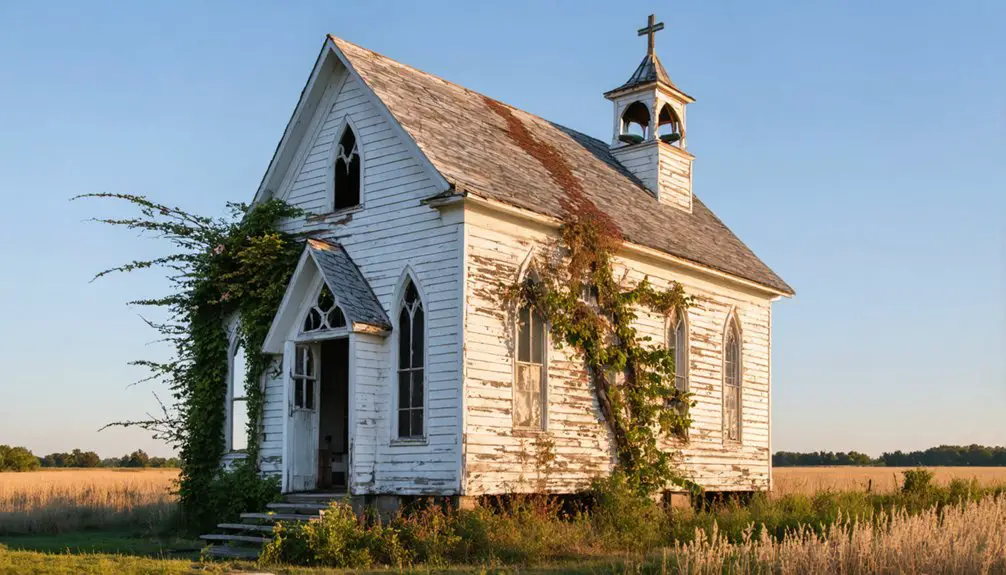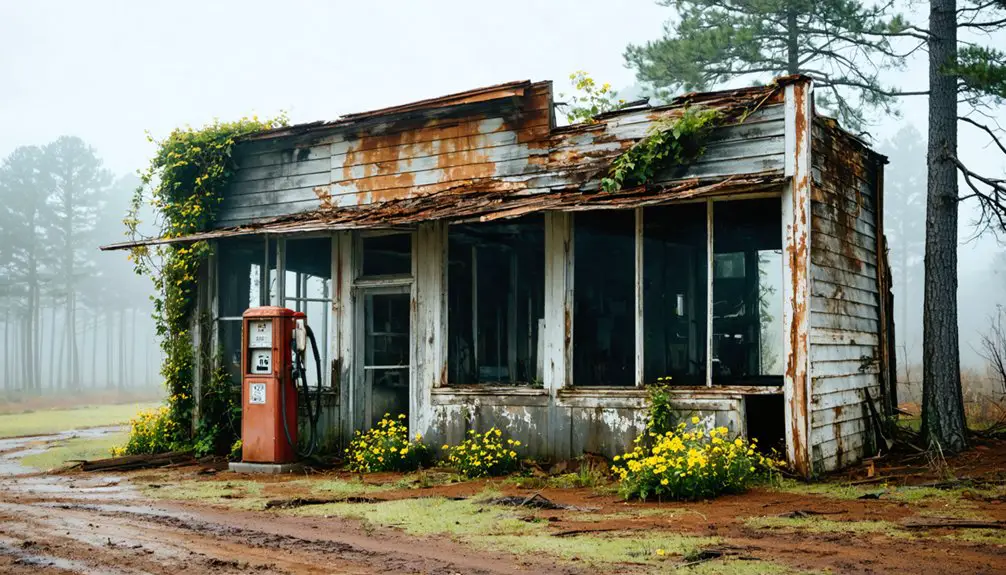You’ll find Commerce’s ghost town remnants in Tunica County, Mississippi, where a once-bustling riverport of 7,000 residents thrived in the 1830s. The town’s decline began with an 1869 fire and worsened when the Mississippi River changed course in 1870, cutting off essential water access. Today, only scattered traces remain of this former county seat, though its legacy lives on through the region’s casino economy and cultural heritage. The site holds countless untold stories of the Delta’s rich past.
Key Takeaways
- Commerce became a ghost town after the Mississippi River changed course in 1870, cutting off vital river access.
- Once Tunica County’s first seat of government in 1834, Commerce declined after fire damage and railroad bypasses.
- The town’s population of 7,000 disappeared as economic activity shifted away from the abandoned river landing site.
- A devastating fire in 1869 and catastrophic tornado in 1955 contributed to Commerce’s complete transformation into farmland.
- The original site remains abandoned today, though the area later revived through casino development in the 1990s.
The Rise and Fall of a Mississippi River Port
While steamboats had already begun transforming river commerce by 1811, the small port town of Commerce, Mississippi, would soon experience both the remarkable rise and eventual decline that characterized many Mississippi River settlements.
The Illinois and Michigan Canal helped establish vital trade connections between Commerce and northern markets, reshaping the economic landscape of river towns.
You’d have seen dramatic changes as river navigation improvements allowed steamboats to reduce the St. Louis to New Orleans journey from months to mere days, spurring explosive growth in trade and settlement.
Freight rates dropped dramatically on the Mississippi River system, making water transport far more economical than overland routes across the Appalachians.
Life Along Commerce Landing
As Commerce Landing emerged in 1834 along the Mississippi River, you’d have witnessed a bustling Southern river town that quickly became Tunica County’s first seat of government.
By 1839, you’d have found yourself among 7,000 residents, including 3,000 enslaved people, all participating in the vibrant river trade that defined the settlement’s character.
Commerce Landing’s bustling river trade supported 7,000 souls by 1839, with nearly half its population living under the burden of slavery.
Walking the streets, you’d have encountered a diverse mix of merchants, farmers, and river workers.
Cultural interactions between Anglo-American settlers and Native Americans, particularly the Choctaw and Chickasaw, shaped the town’s early development.
You’d have enjoyed entertainment from traveling riverboat exhibitions, like Banvard’s floating paintings, while steamboats loaded with goods created a constant hum of commercial activity along the landing.
The town’s success relied on its robust system of auxiliary commercial services including banking, transportation, and warehousing facilities that supported river trade operations.
From Bustling Trade Hub to Abandoned Settlement
Despite its early promise as a thriving Mississippi River port, Commerce’s fortunes took a dramatic turn after 1869 when a devastating fire ravaged the town’s core infrastructure.
You can trace the town’s decline through a series of economic shifts that followed: the Mississippi River’s course changed in 1870, forming a sandbar that cut off essential river access, while major railroads bypassed the settlement entirely. Without transportation links, Commerce’s commercial activities withered. The loss of reliable transportation severely impacted the exchange of goods between Commerce and other regions.
Nature dealt additional blows through epidemics and a catastrophic 1955 tornado that claimed 28 lives and destroyed historical landmarks. Like many Mississippi towns of the era, Commerce suffered greatly from yellow fever epidemics that decimated its population.
By the mid-20th century, you’d hardly recognize the once-bustling trade hub as it transformed into farmland.
Today, only scattered remnants and a Blues Trail marker honoring Robert Johnson’s connection to the area hint at Commerce’s former significance.
Legacy in Modern Tunica County
When Tunica County legalized casino gambling in the early 1990s, you’d witness a remarkable transformation of this once-destitute Delta region into a thriving gaming destination.
While Commerce’s original site lies abandoned, its legacy lives on through the economic transformation that’s reshaped the entire county’s identity.
Though Commerce faded into history, its spirit endures in the sweeping changes that gave Tunica County new purpose and direction.
Today, you’ll find six operating casinos that have helped preserve population levels in an area that might otherwise have followed the fate of Commerce itself.
This gaming-driven development stands in stark contrast to the region’s cultural heritage, which includes Native American settlements, river commerce, and historical events like the 1874 Austin riot.
Though some original communities have vanished beneath the Mississippi Levee system, their stories remain woven into the fabric of modern Tunica’s complex narrative of loss, resilience, and renewal.
The area’s history includes dark swamps and plantations that characterized the landscape before modern development transformed the region.
At its peak, the region employed over 13,000 workers in its bustling casino industry, marking an unprecedented era of economic prosperity.
Preserving the Memory of a Lost River Town
Since Commerce’s decline in the mid-20th century, preserving its memory has relied heavily on cultural heritage rather than physical artifacts.
You’ll find the town’s legacy lives on primarily through oral histories, local folklore, and the Mississippi Blues Trail marker commemorating Robert Johnson’s presence in the 1920s.
While you won’t see many physical remnants of this once-bustling river port, stories of significant events continue to shape regional memory.
The dramatic 1888 Kate Adams steamboat fire and the devastating 1955 tornado remain vivid in local retellings.
Like Rodney, which experienced devastating series of fires in 1837, 1852, and 1869, Commerce faced its share of natural disasters that contributed to its eventual abandonment.
Today, as casino developments and farmland dominate the landscape where Commerce once stood, understanding its history depends on cultural preservation efforts.
Local historical societies occasionally reference the town’s importance in Mississippi riverport history, though formal preservation initiatives remain limited.
Frequently Asked Questions
When Was Commerce, Mississippi Officially Established as a Town?
You’ll find in your town history research that Commerce’s official establishment date was 1839, when it was incorporated as a town, though settlers had founded the community five years earlier.
Did Any Notable Civil War Battles or Events Occur in Commerce?
Truth is stranger than fiction, but you won’t find notable Civil War battles in Commerce. Historical significance wasn’t tied to direct warfare, though nearby conflicts like Vicksburg’s siege impacted the region.
What Was the Peak Population of Commerce During Its Heyday?
You’ll find no specific peak population records for Commerce itself, as it was counted within Rodney’s broader settlement area, which reached around 4,000 residents before ghost town history began its population decline.
Were There Any Churches or Schools Established in Commerce?
A 1955 tornado destroyed one church and school at Abbay & Leatherman plantation. You’ll find limited church history and education legacy, with only Indian Creek School documented in Commerce’s vicinity.
What Indigenous Peoples Originally Inhabited the Commerce Area Before Settlement?
You’ll find the Choctaw and Chickasaw Native tribes were the original inhabitants, sharing a rich cultural heritage in northeastern Mississippi. They descended from the region’s ancient Mississippian mound-building civilization.
References
- https://en.wikipedia.org/wiki/Commerce
- https://mississippifolklife.org/articles/haunted-by-a-ghost-town-the-lure-of-rodney-mississippi
- https://theforgottensouth.com/rodney-mississippi-ghost-town-history-tour/
- https://www.youtube.com/watch?v=pRwwTB53x-Y
- https://www.legendsofamerica.com/ms-rodney/
- https://www.britannica.com/place/Mississippi-River/History-and-economy
- https://www.wttw.com/beyond-chicago-from-the-air/every-hour-brings-something-new-history-of-mississippi-river-commerce
- https://www.battlefields.org/learn/articles/steamboats-and-mississippi-river
- http://mainland.cctt.org/istf2006/history.asp
- http://web.mit.edu/12.000/www/m2010/finalwebsite/background/mississippiriver/mississippi-economic.html



